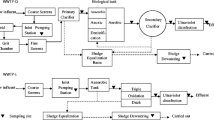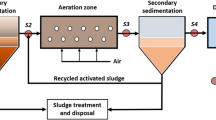Abstract
Integrated constructed wetlands (ICWs) are regarded as one of the most important removal technology for pollutants in rural domestic wastewaters. This study investigated the efficiency of an ICW consisting of a regulating pool, four surface and subsurface flow-constructed wetlands, and a stabilization unit for removing antibiotics and antibiotic resistance genes (ARGs) from rural domestic wastewaters. The results showed that antibiotics leucomycin, ofloxacin, lincomycin, and sulfamethazine, and ARGs sul1, sul2, tetM, and tetO were the predominant antibiotics and ARGs in the influent, respectively. The ICW system could significantly reduce most of the detected antibiotics and ARGs with their aqueous removal rates of 78 to 100 % and >99 %, respectively. Based on the measured concentrations, the total pollution loadings of antibiotics were 3,479 μg/day in the influent and 199 μg/day in the final effluent. Therefore, constructed wetlands could be a promising technology for rural wastewater in removing contaminants such as antibiotics and ARGs.





Similar content being viewed by others
References
APHA (1998) Standard methods for the examination of wastewater, 20th edn. American Public Health Association, Washington DC
Auerbach EA, Seyfried EE, McMahon KD (2007) Tetracycline resistance genes in activated sludge wastewater treatment plants. Water Res 41:1143–1151
Barnes KK, Kolpin DW, Furlong ET, Zaugg SD, Meyer MT, Barber LB (2008) A national reconnaissance of pharmaceuticals and other organic wastewater contaminants in the United States—I) Groundwater. Sci Total Environ 402:192–200
Batt AL, Snow DD, Aga DS (2006) Occurrence of sulfonamide antimicrobials in private water wells in Washington County, Idaho, USA. Chemosphere 64:1963–1971
Chen H, Zhang M (2013) Occurrence and removal of antibiotic resistance genes in municipal wastewater and rural domestic sewage treatment systems in eastern China. Environ Int 55:9–14
Cheng W, Chen H, Su C, Yan S (2013) Abundance and persistence of antibiotic resistance genes in livestock farms: a comprehensive investigation in eastern China. Environ Int 61:1–7
Clesceri L, Greenberg A, Eaton A (Eds.) (2001) Standard methods for the examination of water and wastewater (20th ed.), APHA:Washington
Coleman BL, Louie M, Salvadori MI, McEwen SA, Neumann N, Sibley K, Irwin RJ, Jamieson FB, Daignault D, Majury A, Braithwaite S, Crago B, McGeer AJ (2013) Contamination of Canadian private drinking water sources with antimicrobial resistant Escherichia coli. Water Res 47:3026–3036
Costanzo SD, Murby J, Bates J (2005) Ecosystem response to antibiotics entering the aquatic environment. Mar Pollut Bull 51:218–223
Durham L, Ge M, Cuccia A, Quinn J (2010) Modeling antibiotic resistance to project future rates: quinolone resistance in Escherichia coli. Eur J Clin Microbiol Infect Dis 29:353–356
Gao L, Shi Y, Li W, Niu H, Liu J, Cai Y (2012) Occurrence of antibiotics in eight sewage treatment plants in Beijing, China. Chemosphere 86:665–671
Garcia-Galan MJ, Diaz-Cruz MS, Barcelo D (2008) Identification and determination of metabolites and degradation products of sulfonamide antibiotics. TrAC Trends Anal Chem 27:1008–1022
Garcia-Galan MJ, Rodriguez-Rodriguez CE, Vicent T, Caminal G, Silvia Diaz-Cruz M, Barcelo D (2011) Biodegradation of sulfamethazine by Trametes versicolor: removal from sewage sludge and identification of intermediate products by UPLC-QqTOF-MS. Sci Total Environ 409:5505–5512
Golet EM, Alder AC, Giger W (2002) Environmental exposure and risk assessment of fluoroquinolone antibacterial agents in wastewater and river water of the Glatt Valley Watershed, Switzerland. Environ Sci Technol 36:3645–3651
Huang P, Guo YG, Lou XY, Yuan XW, Xu SJ, Xiao DX, Zhai P, Xu L, Wang ZH, Liu JS (2012) Survey of rural domestic sewage treatment systems of songjiang district in Shanghai, China. Adv Mater Res 573:511–515
Jasper JT, Sedlak DL (2013) Phototransformation of wastewater-derived trace organic contaminants in open-water unit process treatment wetlands. Environ Sci Technol 47:10781–10790
Jia A, Wan Y, Xiao Y, Hu J (2012) Occurrence and fate of quinolone and fluoroquinolone antibiotics in a municipal sewage treatment plant. Water Res 46:387–394
Kümmerer K (2009) Antibiotics in the aquatic environment—a review—part I. Chemosphere 75:417–434
Kotzerke A, Sharma S, Schauss K, Heuer H, Thiele-Bruhn S, Smalla K, Wilke B-M, Schloter M (2008) Alterations in soil microbial activity and N-transformation processes due to sulfadiazine loads in pig-manure. Environ Pollut 153:315–322
Langford K, Lester J (2003) Fate and behavior of endocrine disrupters in wastewater treatment processes. Endocrine disrupters in wastewater and sludge treatment processes:103–143
Leung HW, Minh TB, Murphy MB, Lam JCW, So MK, Martin M (2012) Distribution, fate and risk assessment of antibiotics in sewage treatment plants in Hong Kong, South China. Environ Int 42:1–9
Li B, Zhang T (2010) Biodegradation and adsorption of antibiotics in the activated sludge process. Environ Sci Technol 44:3468–3473
Lindberg RH, Wennberg P, Johansson MI, Tysklind M, Andersson BA (2005) Screening of human antibiotic substances and determination of weekly mass flows in five sewage treatment plants in Sweden. Environ Sci Technol 39:3421–3429
Liu F, Ying GG, Tao R, Zhao JL, Yang JF, Zhao LF (2009) Effects of six selected antibiotics on plant growth and soil microbial and enzymatic activities. Environ Pollut 157:1636–1642
Liu J, Lu Z, Zhang J, Xing M, Yang J (2013a) Phylogenetic characterization of microbial communities in a full-scale vermifilter treating rural domestic sewage. Ecol Eng 61:100–109
Liu L, Liu C, Zheng J, Huang X, Wang Z, Liu Y, Zhu G (2013b) Elimination of veterinary antibiotics and antibiotic resistance genes from swine wastewater in the vertical flow constructed wetlands. Chemosphere 91:1088–1093
Mohring SAI, Strzysch I, Fernandes MR, Kiffmeyer TK, Tuerk J, Hamscher G (2009) Degradation and elimination of various sulfonamides during anaerobic fermentation: a promising step on the way to sustainable pharmacy? Environ Sci Technol 43:2569–2574
Munir M, Wong K, Xagoraraki I (2011) Release of antibiotic resistant bacteria and genes in the effluent and biosolids of five wastewater utilities in Michigan. Water Res 45:681–693
Pruden A, Pei R, Storteboom H, Carlson KH (2006) Antibiotic resistance genes as emerging contaminants: studies in northern Colorado. Environ Sci Technol 40:7445–7450
Pruden A, Arabi M, Storteboom HN (2012) Correlation between upstream human activities and riverine antibiotic resistance genes. Environ Sci Technol 46:11541–11549
Rizzo L, Fiorentino A, Anselmo A (2013) Advanced treatment of urban wastewater by UV radiation: effect on antibiotics and antibiotic-resistant E. coli strains. Chemosphere 92:171–176
Sarmah AK, Meyer MT, Boxall A (2006) A global perspective on the use, sales, exposure pathways, occurrence, fate and effects of veterinary antibiotics (VAs) in the environment. Chemosphere 65:725–759
Shao Y, Pei HY, Hu WR (2013) Nitrogen removal by bioaugmentation in constructed wetlands for rural domestic wastewater in autumn. Desalin Water Treat 51:6624–6631
Su HC, Ying GG, Tao R, Zhang RQ, Zhao JL, Liu YS (2012) Class 1 and 2 integrons, sul resistance genes and antibiotic resistance in Escherichia coli isolated from Dongjiang River, South China. Environ Pollut 169:42–49
Su HC, Ying GG, He LY, Liu YS, Zhang RQ, Tao R (2014) Antibiotic resistance, plasmid-mediated quinolone resistance (PMQR) genes and ampC gene in two typical municipal wastewater treatment plants. Environ Sci Process Impacts [Epub ahead of print]
Tamminen M, Karkman A, Lohmus A, Muziasari WI, Takasu H, Wada S, Suzuki S, Virta M (2011) Tetracycline resistance genes persist at aquaculture farms in the absence of selection pressure. Environ Sci Technol 45:386–391
Tao R, Ying GG, Su HC, Zhou HW, Sidhu JP (2010) Detection of antibiotic resistance and tetracycline resistance genes in Enterobacteriaceae isolated from the Pearl rivers in South China. Environ Pollut 158:2101–2109
Underwood JC, Harvey RW, Metge DW, Repert DA, Baumgartner LK, Smith RL, Roane TM, Barber LB (2011) Effects of the antimicrobial sulfamethoxazole on groundwater bacterial enrichment. Environ Sci Technol 45:3096–3101
Watkinson A, Murby E, Costanzo S (2007) Removal of antibiotics in conventional and advanced wastewater treatment: implications for environmental discharge and wastewater recycling. Water Res 41:4164–4176
Xu W, Zhang G, Li X, Zou S, Li P, Hu Z, Li J (2007) Occurrence and elimination of antibiotics at four sewage treatment plants in the Pearl River Delta (PRD), South China. Water Res 41:4526–4534
Yang JF, Ying GG, Zhao JL, Tao R, Su HC, Liu YS (2011) Spatial and seasonal distribution of selected antibiotics in surface waters of the Pearl Rivers, China. J Environ Sci Health B 46:272–280
Ye F, Li Y (2009) Enhancement of nitrogen removal in towery hybrid constructed wetland to treat domestic wastewater for small rural communities. Ecol Eng 35:1043–1050
Zeng T, Chin YP, Arnold WA (2012) Potential for abiotic reduction of pesticides in prairie pothole porewaters. Environ Sci Technol 46:3177–3187
Zeng T, Arnold WA (2013) Pesticide photolysis in prairie potholes: probing photosensitized processes. Environ Sci Technol 47:6735–6745
Zhang HC, Weber EJ (2013) Identifying indicators of reactivity for chemical reductants in sediments. Environ Sci Technol 47:6959–6968
Zhou LJ, Ying GG, Zhao JL, Yang JF, Wang L, Yang B, Liu S (2011) Trends in the occurrence of human and veterinary antibiotics in the sediments of the Yellow River, Hai River and Liao River in northern China. Environ Pollut 159:1877–1885
Zhou LJ, Ying GG, Liu S, Zhao JL, Chen F, Zhang RQ, Peng FQ, Zhang QQ (2012) Simultaneous determination of human and veterinary antibiotics in various environmental matrices by rapid resolution liquid chromatography–electrospray ionization tandem mass spectrometry. J Chromatogr A 1244:123–138
Zhou LJ, Ying GG, Liu S, Zhao JL, Yang B, Chen ZF, Lai HJ (2013) Occurrence and fate of eleven classes of antibiotics in two typical wastewater treatment plants in South China. Sci Total Environ 452:365–376
Acknowledgments
The authors would like to acknowledge the financial support from the CAS Key Project (KZZD-EW-09), Ministry of Environmental Protection (MEP 201309031), and Natural Science Foundation of China (NSFC U113305 and 41303077).
Author information
Authors and Affiliations
Corresponding authors
Additional information
Responsible editor: Gerald Thouand
Electronic supplementary material
Below is the link to the electronic supplementary material.
ESM 1
(DOC 222 kb)
Rights and permissions
About this article
Cite this article
Chen, J., Liu, YS., Su, HC. et al. Removal of antibiotics and antibiotic resistance genes in rural wastewater by an integrated constructed wetland. Environ Sci Pollut Res 22, 1794–1803 (2015). https://doi.org/10.1007/s11356-014-2800-4
Received:
Accepted:
Published:
Issue Date:
DOI: https://doi.org/10.1007/s11356-014-2800-4




